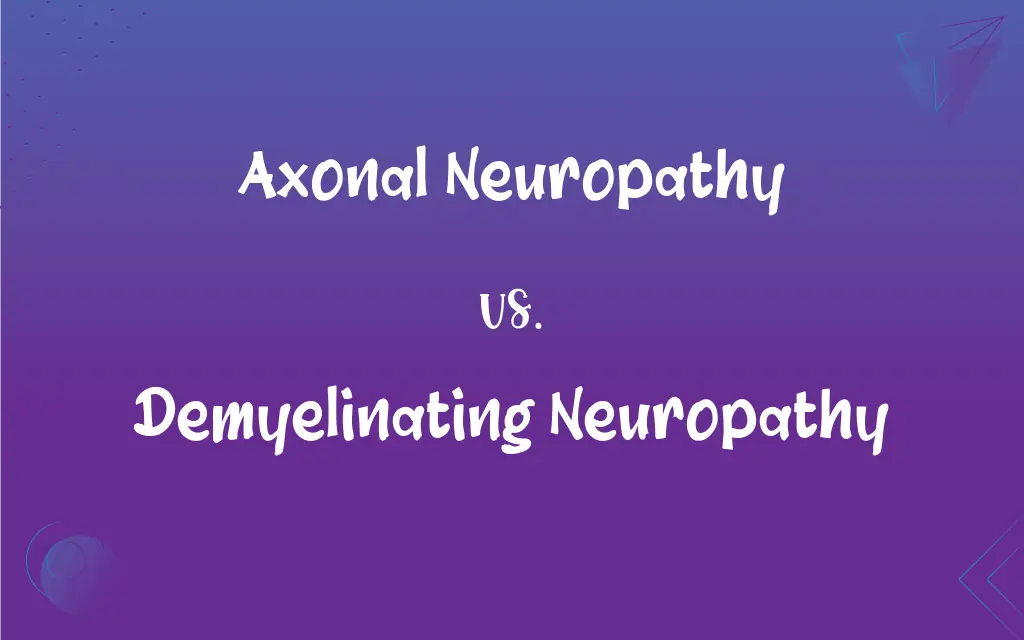Axonal Neuropathy vs. Demyelinating Neuropathy: What's the Difference?
By Janet White || Published on March 11, 2024
Axonal neuropathy involves nerve fiber damage, affecting signal strength; demyelinating neuropathy involves myelin sheath damage, slowing signal transmission.

Key Differences
Axonal neuropathy is a condition characterized by damage to the axon, the part of a nerve cell that carries electrical signals to other nerves or muscles. This type of neuropathy can lead to a decrease in the strength of the signal being transmitted, often resulting in muscle weakness and loss of muscle control. Demyelinating neuropathy, on the other hand, involves damage to the myelin sheath, the protective covering that surrounds nerve fibers. This damage disrupts the normal transmission of electrical signals along the nerves, leading to a slowing of nerve signal speed. It can cause symptoms such as numbness, tingling, and a range of other neurological deficits.
In axonal neuropathy, the primary issue is the degeneration or dysfunction of the nerve axons themselves. This can be due to a variety of causes, including physical injury, systemic diseases, or genetic conditions. As the axons deteriorate, the ability of the nerves to communicate effectively is compromised. Demyelinating neuropathy involves a different pathophysiological process, where the immune system mistakenly attacks the myelin sheath or it becomes damaged due to other conditions, leading to a disruption in nerve signal conduction.
The diagnostic approaches for axonal neuropathy and demyelinating neuropathy also differ. For axonal neuropathy, tests may focus on the function and integrity of the nerve axons, such as electromyography (EMG) and nerve conduction studies. For demyelinating neuropathy, additional tests may be employed to assess the condition of the myelin sheath, including more specialized imaging techniques or nerve biopsy.
Treatment strategies for axonal neuropathy often aim at the underlying cause of the axon damage and managing symptoms. This might include medications to alleviate pain or physical therapy to maintain muscle strength. For demyelinating neuropathy, treatment may involve immunomodulatory therapies to reduce the immune system's attack on the myelin sheath, alongside symptomatic management.
The prognosis for axonal neuropathy and demyelinating neuropathy can vary based on the extent of the damage and the effectiveness of treatment. Axonal neuropathy may be progressive, depending on the cause, and lead to significant disability. Demyelinating neuropathy might have a more variable course, with potential for remission or improvement with appropriate treatment.
ADVERTISEMENT
Comparison Chart
Nature of Damage
Damage to nerve axons
Damage to the myelin sheath
Effect on Signal
Decreases signal strength
Slows signal transmission
Common Symptoms
Muscle weakness, loss of muscle control
Numbness, tingling, slowed reflexes
Diagnostic Tests
Electromyography (EMG), nerve conduction studies
Nerve conduction studies, specialized imaging, nerve biopsy
Treatment Focus
Addressing underlying cause, symptom management
Immunomodulatory therapies, symptom management
ADVERTISEMENT
Axonal Neuropathy and Demyelinating Neuropathy Definitions
Axonal Neuropathy
A neuropathic disorder impairing nerve signal transmission.
Treatment for axonal neuropathy focuses on improving nerve health.
Demyelinating Neuropathy
A disorder where the myelin sheath of nerves is damaged.
Demyelinating neuropathy often causes tingling sensations in the limbs.
Axonal Neuropathy
A condition of nerve damage leading to reduced electrical signal strength.
The patient's muscle weakness was diagnosed as axonal neuropathy.
Demyelinating Neuropathy
The breakdown of myelin sheath leading to nerve dysfunction.
Patients with demyelinating neuropathy may experience fluctuating symptoms.
Axonal Neuropathy
Damage to the nerve fibers resulting in neurological symptoms.
Physical therapy is part of the treatment plan for axonal neuropathy.
Demyelinating Neuropathy
A condition impairing nerve signal speed and coordination.
Immunotherapy is a common approach to treat demyelinating neuropathy.
Axonal Neuropathy
Degeneration of nerve axons affecting nerve function.
Axonal neuropathy requires targeted therapy to manage symptoms.
Demyelinating Neuropathy
A neuropathic disease affecting the protective nerve covering.
Research on demyelinating neuropathy aims to restore myelin sheath integrity.
Axonal Neuropathy
A loss of nerve fiber function leading to sensory and motor deficits.
Axonal neuropathy can severely impact quality of life without intervention.
Demyelinating Neuropathy
Damage to nerve insulation slowing electrical impulses.
Early diagnosis of demyelinating neuropathy is crucial for effective treatment.
FAQs
What causes axonal neuropathy?
Causes include physical injury, systemic diseases, and genetic disorders.
What treatments are available for demyelinating neuropathy?
Treatments include immunomodulatory therapies and symptom management.
Is demyelinating neuropathy a progressive disease?
It can be, but its course is variable and sometimes responds well to treatment.
What are the symptoms of demyelinating neuropathy?
Symptoms include numbness, tingling, and slowed reflexes.
How is axonal neuropathy diagnosed?
Through electromyography (EMG) and nerve conduction studies.
Can axonal neuropathy be cured?
There's no cure, but treatment can manage symptoms and improve quality of life.
How does axonal damage affect the body?
It leads to muscle weakness and loss of sensory functions.
What's the difference in treatment between axonal and demyelinating neuropathy?
Axonal focuses on underlying causes, while demyelinating often involves immunotherapy.
Are axonal neuropathy and demyelinating neuropathy related?
They are different in mechanism but both affect nerve function.
Can lifestyle changes help with axonal neuropathy?
Yes, such as physical therapy and avoiding factors that worsen the condition.
Is there a genetic predisposition to axonal neuropathy?
Yes, certain forms are linked to genetic mutations.
What research is being done on demyelinating neuropathy?
Research focuses on understanding the disease mechanism and finding new treatments.
What support is available for individuals with axonal neuropathy?
Support ranges from medical treatment to physical and occupational therapy.
How does temperature affect demyelinating neuropathy symptoms?
Extreme temperatures can exacerbate symptoms, making temperature regulation important.
What is the prognosis for someone with demyelinating neuropathy?
Prognosis varies, depending on the severity and response to treatment.
Can demyelinating neuropathy lead to disability?
Yes, especially if untreated, it can lead to significant functional impairment.
How important is early diagnosis for axonal neuropathy?
Crucial for preventing further nerve damage and managing symptoms effectively.
Can exercise benefit people with demyelinating neuropathy?
Yes, tailored exercise programs can help maintain muscle strength and mobility.
How does the immune system affect demyelinating neuropathy?
It may mistakenly attack the myelin sheath, leading to nerve damage.
Can axonal neuropathy affect all ages?
Yes, it can affect individuals at any age, depending on the cause.
About Author
Written by
Janet WhiteJanet White has been an esteemed writer and blogger for Difference Wiki. Holding a Master's degree in Science and Medical Journalism from the prestigious Boston University, she has consistently demonstrated her expertise and passion for her field. When she's not immersed in her work, Janet relishes her time exercising, delving into a good book, and cherishing moments with friends and family.
































































